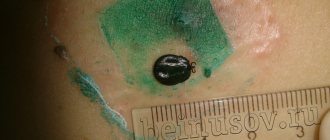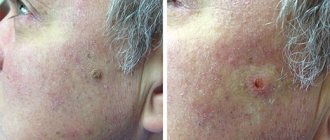Papillomas are areas of pathological proliferation of cells in the upper layer of the skin and mucous membrane. Over time, these benign tumors can become a source of cancer, so many patients are concerned with the question: how to get rid of papillomas. Let's figure out why papillomas occur on the body, why they are dangerous to health, and whether they need to be removed.
Appointment with a dermatologist - 1000 rubles. Removing papilloma using the best method - radio knife - 500 rubles. Consultation with a specialized doctor based on the results of ultrasound and tests - 500 rubles. (optional).
Causes of papillomas
The content of the article
The causes of the appearance of papillomas on the body are divided into main and indirect, which act as a trigger for the development of the disease.
The main cause of skin papillomas is infection with the human papillomavirus (HPV) from the Papillomavirus group. HPV is a generalized term that refers to a whole group of viral agents that can infect epidermal structures and mucous membranes, and in some cases even provoke cancer.
According to statistics, the prevalence of HPV on the planet is global - the virus is in the body of 90% of adults. Science knows 100 strains of the papilloma virus, but not all of them are dangerous - the characteristics, localization zones and likelihood of developing cancer are different for each strain. The most dangerous are considered to be HPV 16.18, 31, 33 and 35, which in 98% of cases cause cervical cancer in women.
HPV does not tolerate aggressive environmental factors well, so it practically does not spread through the air. The main route of transmission is contact. The maximum risk of infection occurs through contact with the skin of a sick person.
The virus first penetrates the basal layer of the epidermis (skin), where it subsides for several months. The incubation period can last up to several years. If the immune system is weak, then the disease will show symptoms within a month, and the average period for symptoms to appear is 6 months.
The following reasons provoke the appearance of papillomas on the skin:
- Decreased immunity - colds, injuries, chronic diseases, HIV, AIDS;
- Microtraumas, scratches, open wounds on the surface of the patient’s skin;
- Hormonal imbalance, which may be associated with pregnancy, lactation, menopause, etc.;
- promiscuous sexual intercourse, oral sex with a carrier of the papilloma virus;
- nervous-emotional tension, stress, physical or mental fatigue;
- bad habits, poor nutrition;
- endometriosis.
Diet
Diet to boost immunity
- Efficacy: therapeutic effect after 3 weeks
- Terms: 1-3 months or more
- Cost of products: 1600-1800 rubles. in Week
Nutrition should be complete and varied, since it is very important to compensate for the deficiency of vitamins and minerals in order to strengthen the patient’s immunity. The following products must be included in the menu:
- Peppers, citrus fruits, currants, rosehip decoction, sauerkraut - they contain a lot of vitamin C.
- Sea fish.
- Vegetable oils.
- Greens, fresh vegetables.
- Lean meats.
- Dairy products.
- Honey.
The following products should be excluded from the menu:
- Fried food.
- Sugar, sweets.
- Alcohol.
- Animal fats.
- Preservatives, smoked products.
Symptoms of papillomas
Most often the papilloma virus
in women and men it does not manifest itself at all; its diagnosis is possible only through a special analysis. Vivid signs of infection are observed only in a small number of infected people, and even these often disappear after a short time.
For a long time, the patient does not even suspect that he has become a carrier of the infection, contagious to others. The main symptom of infection - a skin neoplasm papilloma - appears when the virus is in full control of the body. In this case, papilloma can grow on any part of the body - on the skin and mucous membranes.
There are a huge number of photos on the Internet that clearly show what papilloma and its colony look like. This is a skin growth in the form of a dome-shaped compaction or papule on a thin stalk. The papule may also have a thickened base. The color of the papilloma is also ambiguous - for some it is a pale pink “wart”, and for others it is a dark brown growth. Some strains of papillomavirus form entire colonies of neoplasms, which gradually merge into one unpleasant-looking multi-headed wart, reminiscent of cauliflower.
Diagnostics
To make an accurate diagnosis of papillomatosis, a woman needs to undergo a comprehensive examination of the body and the area of skin where the benign neoplasm is located.
Diagnosis of papillomas takes place in several stages, namely:
- visual examination by a dermatologist;
- donation of venous blood for its biochemical study and determination of papillomavirus virions;
- examination of the deeper epithelial layers of the wart using a dermatoscope;
- collection of capillary blood for clinical analysis;
- selection of a piece of papilloma for further histological examination to exclude the oncological nature of the origin of the tumor;
- delivery of morning urine to determine its biochemical composition and general indicators of a woman’s health.
Localization of papillomas in the intimate area, on the genitals and around the anus may require additional examination by a gynecologist, as well as testing for the presence of sexually transmitted infections.
Variety of papillomas: 7 main types
Scientists know more than 100 types of HPV, but the most common are 10 types of papillomas:
- Plantar papillomas
. Causes papilloma on the leg - papillomavirus types 1, 2, 4. Plantar papillomas look like growths on the soles of the feet. Plantar warts can be single or multiple. Over time, it becomes painful for a person affected by the disease to walk. Plantar papilloma is often confused with a callus and is not sought medical attention, while the infection affects new areas of the skin. - Vulgar papillomas
. These are oval, keratinized lumps with a yellowish tint, usually appearing on the hands of adults. In children, such tumors can be found on the knees. - Flat papillomas
. The result of activation of HPV types 3, 10. The growths look like flat, smooth bumps. - Lewandowski-Lutz papillomas . The second name is epidermodysplasia verruciformis. The infection results in the formation of many mottled, multi-colored warts on the arms and legs.
- Filiform papillomas. Formed in older people. Warts look like yellowish bumps. Placed on the eyelids, groins, armpits, and neck. Threaded papilloma injured by clothing or as a result of scratching requires urgent treatment, otherwise inflammation and complications cannot be avoided.
- Juvenile papillomas . Associated with infection with papillomavirus types 6, 11. Formed in the larynx. As a result, breathing becomes difficult and speech deteriorates. The virus spreads during childbirth, transmitted to the newborn from the mother.
- Genital warts . The occurrence of genital warts is the main manifestation of infection, the source of which was the human papillomavirus. Visually, genital warts look like ordinary warts, can be small in size (up to a centimeter), have a flesh-colored or pinkish color, a slightly bumpy or completely smooth surface. The most common place for the formation of genital warts is the external genitalia. In men, these formations appear on the scrotum and penis. In women - on the labia majora and minora, on the cervix, near the clitoris, in the vagina. If condylomas are irritated, itching and bleeding may occur during sexual intercourse. Such papillomas transform into cancerous tumors.
Complications
Although papillomas for the most part imply benign formations, their formation cannot be ignored. Many types of viruses can cause cancer, so many people wonder how to prevent the spread of papilloma after infection. The following types of HPV are distinguished depending on the degree of threat of cancer:
- not implying the appearance of oncology,
- having a low degree and a high degree of oncology.
When is it recommended to contact a specialist? If there are formations, you should immediately contact a doctor specializing in the relevant profile.
Complex conditions are a consequence of untreated papillomas
- Local epithelial hyperplasia . Consequence of infection with papillomavirus types 13, 32. The affected area looks like a rash of papillary neoplasms on the tongue and along the edges of the lips. Papillomas can merge with each other, forming a clearly visible area.
- Precancerous conditions and cancer -
many forms of the human papillomavirus cause the development of neoplasms prone to malignant degeneration. It is in this regard that early diagnosis and detection of papillomavirus makes it possible to detect and remove oncological tumors of the cervix and other organs in the early stages of their development.
Peculiarities
Despite the fact that papillomas are benign in nature, they can be dangerous to human health. If the formation is damaged, a scar will appear or blood poisoning will occur. Therefore, it is strictly forbidden to pick at the growths, scratch them, and especially try to cut them off yourself. This often causes the tumor to spread.
Papillomas are dangerous due to their viral nature. There are more than hundreds of types of HPV infection. Some of them are harmless, but there are also those that are fatal. Thus, HPV 16 and 18 can cause cancer. If the growth begins to change shape, you should immediately go to the hospital.
You can independently determine whether neoplasms are dangerous by their appearance. Melanomas, unlike papillomas, are asymmetrical, do not have clear boundaries, have different colors and are more than 6 mm in diameter. However, to accurately determine the nature of the formation, you need to rely only on histological examination, PCR and DNA analysis of the virus.
How dangerous are papillomas on the body: why they need to be removed
Papillomas are harmless only in appearance. These neoplasms, in the absence of timely and adequate treatment, quickly spread throughout the body to healthy tissue. This process is called autoinaculation. The result of the proliferation of neoplasms is at least multiple warts.
Of course, warts - papillomas on the body - are very ugly, but this is not the only problem. A good dermatologist will tell you why papillomas on the body are dangerous - such neoplasms are susceptible to melanization - malignant degeneration of the tumor. How quickly the process will proceed and whether it will begin at all depends on the location of the papilloma and the type of HPV. Genital warts growing on the cervix are especially dangerous. The degeneration of such formations into cancer occurs in every second case.
The structures that form on the skin as a result of damage by the papilloma virus are usually not accompanied by pain, itching or burning, which often causes negligence on the part of the patient. But since papillomas almost always come into contact with clothing, there is a high risk of damage. The result will be severe bleeding, infection and the formation of unsightly scars on the skin. From all this follows the answer to the question of whether it is necessary to remove papillomas on the body - of course it is necessary!
Classification
There are several types of papillomas that can appear on the neck and other places:
- Thread-like - a yellowish formation, grows quickly, has a long stalk, and a ball at the end.
- Flat – protrude slightly above the skin, pink or brown.
- Simple or vulgar - large formations with dense irregular edges protrude several millimeters above the skin.
Most often, flat papillomas and warts appear in the neck area.
Taking into account the degree of oncogenicity, the following types of such formations are distinguished:
- Low degree - the risk of developing a malignant process is likely only in the presence of a hereditary predisposition.
- Moderate degree - a malignant process can develop if there is constant exposure to harmful factors, both external and internal.
- High degree - high probability of developing a malignant tumor.
Outdated and modern methods of removing papillomas on the body
It is impossible to get rid of papillomas at home without consequences. The procedure is performed by a dermatologist, and in the case of precancer, by an oncologist. Before this, the patient must undergo tests, including:
- blood test for tumor markers;
- PCR diagnostics;
- taking papilloma tissue for histological examination.
In St. Petersburg and other Russian cities, several methods are used to remove papillomas on the body. To understand which method to choose, let's look at the table.
| Method | How is it carried out? | Advantages | Flaws |
| Surgery | A radical and very traumatic method of removing papillomas | Large tumors can be cut off | Traumaticity. Risk of infection and bleeding. Clearly visible scars remain forever. |
| Cryodestruction | Removing papillomas using liquid nitrogen | Does not require strong anesthesia, as the cold is freezing | Possibility of injury to healthy tissue. Inability to control the depth of impact. A scar remains. |
| Electrocoagulation | Destruction of a neoplasm by an electrical impulse. It is rarely used in medical centers where there is no new equipment. | Cheap technique | Cauterization is an unpleasant procedure. Possible scarring. Requires strong pain relief |
| Laser removal of papillomas | Destruction of a build-up with a directed laser beam | There is no need for preparation, no rehabilitation required - the wound heals immediately. No scars or scars. The procedure lasts only a few minutes. The laser activates skin regeneration, ensuring rapid healing. | The cost of laser papilloma removal is higher than the price of previous methods. |
| Removal of papillomas with a radio knife | The safest and most painless way to remove papillomas from the body. | No preparation needed. Rehabilitation is also not needed. The radioknife is equipped with a coagulator, which immediately stops bleeding by sealing damaged vessels. After removing papillomas with a radio knife, no scars remain, so the procedure is prescribed to get rid of tumors on the face and intimate parts of the body. Radio radiation activates skin restoration, so the wound heals instantly. | The price of removing papillomas using radio wave techniques is slightly higher than laser removal. |
What is the best way to treat?
A large number of papillomas certainly causes inconvenience and does not look aesthetically pleasing. However, this is not a reason to use old-fashioned methods for removal with thread, pliers or a blowtorch.
For single small (1x1 mm) formations, celandine juice
- a proven folk remedy.
When there are many papillomas or they are large, this method is not suitable
, as it can last for months and lead to severe inflammation.
Removal using radio wave surgery is much more convenient and effective
The operation does not require special preparation, is practically painless, and after it you can drive a car.
Once I had the opportunity to remove about 70 papillomas from one patient at once. It is difficult to convey all the joy of a person who got rid of them, whom they tormented for several years.
Can removal of papillomas be considered a treatment for HPV?
Unfortunately no. By removing papillomas, a dermatologist only eliminates manifestations of papillomavirus that can develop into cancer. The virus itself remains in the body. There are currently no specific drugs to cope with the human papillomavirus, and therefore the main therapy is aimed at mechanically eliminating tumors caused by the virus.
The infection is stopped with antiviral agents, which will be effective if the immune system is strong. Therefore, immunotherapy is carried out in parallel. While the virus lives in the body, papilloma cannot be cured forever.
Recommendations
The incubation period can last up to a year; If the body’s immune system has high resistance, then we can expect that the infection will not manifest itself in any way. This is why prevention is extremely important. To do this, you must follow the following rules:
- strengthen the immune system: eat right, take vitamin and mineral complexes, walk in the fresh air, play sports;
- avoid casual sex without using barrier contraceptives;
- visit a gynecologist or urologist at least once a year.
Vaccinations are recommended as one of the most reliable means of prevention. 2 vaccines have been developed - Cervarix and Gardasil. Both drugs contain protein particles from the membranes of microorganisms. The DNA of the virus itself is absent, so such a similar drug is completely safe.
Which doctor treats papillomas and where is the best place to remove papillomas on the body in St. Petersburg?
Many patients are interested in which doctor treats papillomas. This is done by specialists - dermatologists, gynecologists, urologists and oncologists. It all depends on the location of the tumor.
Specialists at the Diana Clinic in St. Petersburg conduct an initial examination and confirm the diagnosis. Then the papillomas are removed with a laser and radio knife, using the latest devices. By contacting our medical center, the patient receives a detailed consultation and can undergo all tests, including oncology. Removal of papillomas is carried out without pain or complications.










